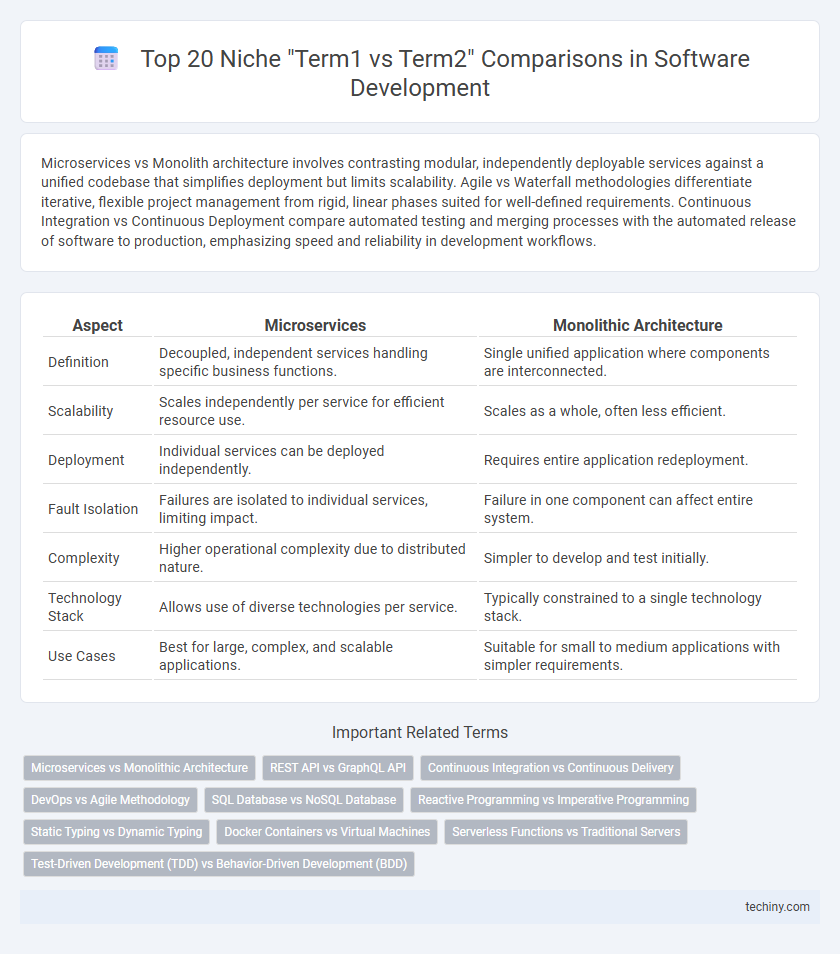Microservices vs Monolith architecture involves contrasting modular, independently deployable services against a unified codebase that simplifies deployment but limits scalability. Agile vs Waterfall methodologies differentiate iterative, flexible project management from rigid, linear phases suited for well-defined requirements. Continuous Integration vs Continuous Deployment compare automated testing and merging processes with the automated release of software to production, emphasizing speed and reliability in development workflows.
Table of Comparison
| Aspect | Microservices | Monolithic Architecture |
|---|---|---|
| Definition | Decoupled, independent services handling specific business functions. | Single unified application where components are interconnected. |
| Scalability | Scales independently per service for efficient resource use. | Scales as a whole, often less efficient. |
| Deployment | Individual services can be deployed independently. | Requires entire application redeployment. |
| Fault Isolation | Failures are isolated to individual services, limiting impact. | Failure in one component can affect entire system. |
| Complexity | Higher operational complexity due to distributed nature. | Simpler to develop and test initially. |
| Technology Stack | Allows use of diverse technologies per service. | Typically constrained to a single technology stack. |
| Use Cases | Best for large, complex, and scalable applications. | Suitable for small to medium applications with simpler requirements. |
Microservices vs Monolithic Architecture
Microservices architecture breaks down applications into smaller, independent services that communicate over APIs, enhancing scalability and deployment flexibility. Monolithic architecture consolidates all functionalities into a single codebase, simplifying development but limiting scalability and fault isolation. Organizations prioritizing rapid iteration and cloud-native deployment often favor microservices for their modularity and resilience.
REST API vs GraphQL API
REST API and GraphQL API differ fundamentally in data fetching methods, where REST uses multiple endpoint calls for resource-based data retrieval while GraphQL enables clients to request exactly the data they need via a single endpoint. REST APIs rely on fixed data structures defined by server endpoints, leading to potential over-fetching or under-fetching, whereas GraphQL's flexible query language optimizes network usage by allowing precise queries and aggregating related data in one request. Performance considerations favor GraphQL in complex applications requiring dynamic data interaction, but REST's simplicity and caching mechanisms remain effective for straightforward resource operations.
Continuous Integration vs Continuous Delivery
Continuous Integration (CI) emphasizes frequent code integration into a shared repository to detect bugs early through automated testing. Continuous Delivery (CD) extends CI by automating the release process, ensuring that code changes can be deployed to production environments reliably and quickly. CI reduces integration issues, while CD enhances deployment speed and stability, enabling more efficient software release cycles.
DevOps vs Agile Methodology
DevOps emphasizes continuous integration, continuous delivery (CI/CD), and automation to streamline software deployment and operations, while Agile methodology focuses on iterative development, collaboration, and flexible response to change. DevOps integrates development and IT operations teams to reduce deployment time and improve system reliability, whereas Agile prioritizes customer feedback and adaptive planning through sprints and user stories. Combining DevOps with Agile practices enhances software quality, accelerates release cycles, and fosters a culture of collaboration between development and operations.
SQL Database vs NoSQL Database
SQL databases use structured query language for defining and manipulating data with a fixed schema ideal for complex queries and transactions. NoSQL databases offer flexible schemas suitable for handling unstructured data, horizontal scaling, and distributed architecture. Performance and scalability requirements determine the choice between SQL's ACID compliance and NoSQL's eventual consistency models.
Reactive Programming vs Imperative Programming
Reactive Programming emphasizes asynchronous data streams and event-driven architecture for handling dynamic data flow, while Imperative Programming relies on explicit step-by-step instructions to manipulate program state. Reactive paradigms leverage observables, backpressure, and non-blocking operations to enhance scalability and responsiveness. Imperative approaches, common in traditional software development, prioritize control flow and direct state mutations, often leading to synchronous processing.
Static Typing vs Dynamic Typing
Static typing enforces type checking at compile-time, enabling early error detection and improved code reliability, while dynamic typing performs type checks at runtime, offering greater flexibility and faster prototyping. Languages like Java and C++ use static typing, providing strict type safety and optimized performance, whereas Python and JavaScript rely on dynamic typing, enhancing developer productivity and ease of use. Static typing aids in maintaining large codebases with clear contracts, whereas dynamic typing accelerates development cycles in smaller or experimental projects.
Docker Containers vs Virtual Machines
Docker Containers offer lightweight, portable environments by sharing the host OS kernel, enabling faster startup times and efficient resource utilization compared to Virtual Machines, which run full guest OS instances requiring more system resources. Containers provide consistency across multiple development, testing, and production environments, making them ideal for microservices architecture, while Virtual Machines ensure stronger isolation and compatibility for legacy applications. Choosing between Docker Containers and Virtual Machines depends on use cases like scalability, deployment speed, and security requirements within software development workflows.
Serverless Functions vs Traditional Servers
Serverless functions offer scalable, event-driven execution without the need for server management, significantly reducing operational overhead compared to traditional servers. Traditional servers require continuous maintenance, provisioning, and scaling, which can lead to higher costs and slower deployment cycles. In contrast, serverless architecture enables automatic scaling and pay-as-you-go billing models, optimizing resource usage and accelerating development timelines.
Test-Driven Development (TDD) vs Behavior-Driven Development (BDD)
Test-Driven Development (TDD) emphasizes writing unit tests before code to ensure functionality and detect defects early, focusing primarily on internal logic. Behavior-Driven Development (BDD) expands on TDD by promoting collaboration between developers, testers, and business stakeholders through shared, human-readable scenarios that define application behavior. Both methodologies improve software quality and maintainability but differ in scope, with TDD targeting code correctness and BDD enhancing communication and specifying user expectations.
Sure! Here’s a list of niche and specific "term1 vs term2" comparisons in the context of Software De Infographic

 techiny.com
techiny.com